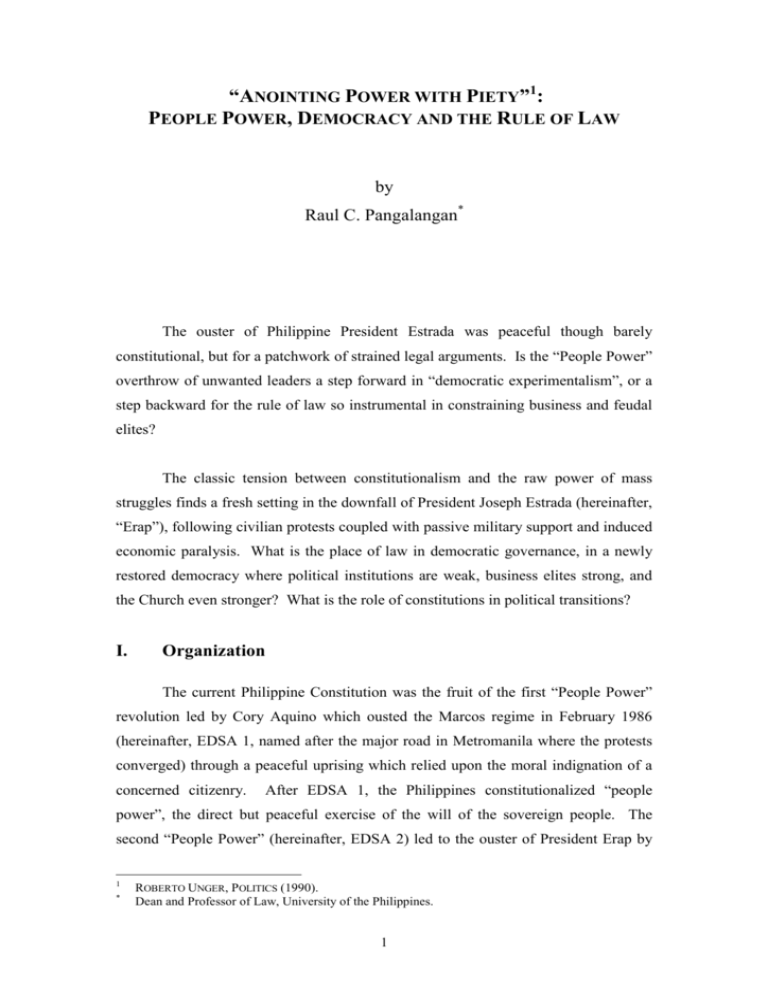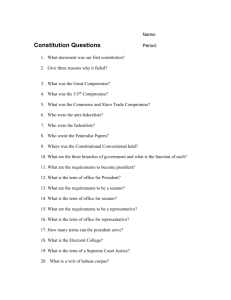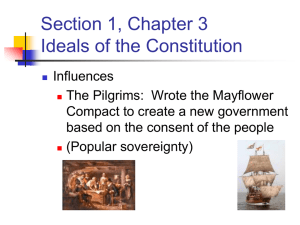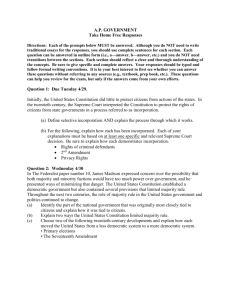'People Power', Democracy and the Rule of Law
advertisement

“ANOINTING POWER WITH PIETY”1: PEOPLE POWER, DEMOCRACY AND THE RULE OF LAW by Raul C. Pangalangan* The ouster of Philippine President Estrada was peaceful though barely constitutional, but for a patchwork of strained legal arguments. Is the “People Power” overthrow of unwanted leaders a step forward in “democratic experimentalism”, or a step backward for the rule of law so instrumental in constraining business and feudal elites? The classic tension between constitutionalism and the raw power of mass struggles finds a fresh setting in the downfall of President Joseph Estrada (hereinafter, “Erap”), following civilian protests coupled with passive military support and induced economic paralysis. What is the place of law in democratic governance, in a newly restored democracy where political institutions are weak, business elites strong, and the Church even stronger? What is the role of constitutions in political transitions? I. Organization The current Philippine Constitution was the fruit of the first “People Power” revolution led by Cory Aquino which ousted the Marcos regime in February 1986 (hereinafter, EDSA 1, named after the major road in Metromanila where the protests converged) through a peaceful uprising which relied upon the moral indignation of a concerned citizenry. After EDSA 1, the Philippines constitutionalized “people power”, the direct but peaceful exercise of the will of the sovereign people. The second “People Power” (hereinafter, EDSA 2) led to the ouster of President Erap by 1 * ROBERTO UNGER, POLITICS (1990). Dean and Professor of Law, University of the Philippines. 1 Gloria Macapagal-Arroyo in January 2001. In May 2001, Erap’s supporters, typically poor and uneducated, converged on EDSA once more and marched to the presidential palace, asking for their heroes’ return (hereinafter, EDSA 3), committing acts of violence which compelled Arroyo to declare a “state of rebellion”. In this paper, I examine first, the constitutional and factual framework for EDSA 2; second, I will situate EDSA 2 within the constitutional history of the Philippines, more specifically, vis-à-vis the virtually bloodless transition from the Marcos regime to Cory Aquino’s democracy; and third, I will look at the implications of EDSA 2 for the future of democratic and rule-based governance in the Philippines. II. Institutionalization of “Direct Democracy” after EDSA 1 The Philippines’ post-Marcos Constitution (hereinafter, the 1987 Constitution) “institutionalized people power” 2 and the Supreme Court has since “rhapsodized people people” 3 in several cases where the “direct initiative” clauses of the Constitution had been invoked. These clauses allow direct initiative for the following: (a) To propose or repeal national and local laws;4 (b) To recall local government officials, and propose or repeal local laws;5 and (c) To propose amendments to the Constitution.6 The Congress has passed implementing laws, which have been applied, tested and affirmed before the Supreme Court. The Local Government Code7 provided for the recall of local officials by either the direct call of the voters, or through “preparatory recall assembly” consisting of local government officials, which was 2 3 4 5 6 7 Subic Bay Metropolitan Authority v. Commission on Elections, 26 September 1996. Defensor-Santiago v. Commission on Elections, 19 March 1997 (hereinafter, PIRMA I). Const., art. VI, sec. 32. (“a system of initiative and referendum … whereby the people can directly propose or enact laws or approve or reject any act or law or part thereof [upon] a petition therefor signed by at least ten per centum of the total number of registered voters, of which every legislative district must be represented by at least three per centum of the registered voters thereof”). Const., art. X, sec. 3 (“a local government code … with effective mechanisms of recall, initiative, and referendum”). Const., art. XVII, sec. 2 (“directly proposed by the people through initiative upon a petition of at least twelve per centum of the total number of registered voters, of which every legislative district must be represented by at least three per centum of the registered votes therein …). Republic Act No. 7160. 2 hailed by the Supreme Court as an “innovative attempt … to remove impediments to the effective exercise by the people of their sovereign power.”8 The Congress has also enacted the Initiative and Referendum Act (hereinafter, the Initiative Law)9, which provided for three systems of initiative, namely, to amend the Constitution; to propose, revise or reject statutes; and to propose, revise or reject local legislation. In a case involving the creation and scope of a special economic zone created out of Subic Bay, a former U.S. military base 10 , the Supreme Court hailed the Initiative Law as “actualizing [] direct sovereignty” and “expressly recogniz[ed the people’s] residual and sovereign authority to ordain legislation directly through the concepts and processes of initiative and of referendum.” The first wrinkle on this neat constitutional framework appeared in 1997, when then President Fidel Ramos (Cory Aquino’s successor), through willing cohorts, tried to amend the Constitution to lift term limits which banned him from remaining in office after his term ended in 1998. He was rebuffed by the Supreme Court, following protests by people who saw a dark reminder of a similar maneuver by Marcos which led to the death of Philippine democracy in 1972. Since the proposal was politically unpopular, a shadowy private group called the People’s Initiative for Reforms, Modernization and Action (PIRMA or, literally translated to Filipino, “signature”) instead launched a signature campaign asking for that constitutional amendment, invoking the direct initiative law. That attempt was rejected twice by the Supreme Court11, which went to great lengths to say that the direct initiative clauses of the Constitution were not self-executory; that they thus required congressional implementation; and that Congress’s response, i.e., the Initiative Law, was “inadequate”– notwithstanding that it expressly referred to constitutional amendments – and thus cannot be relied upon by PIRMA. A dissenting opinion found this “a strained interpretation … to defeat the intent” of the law. Another dissent stated: “It took only one million people to stage a 8 9 10 Garcia v. Commission on Elections, 5 October 1993. Republic Act No. 6753. Subic Bay Metropolitan Authority v.Commission on Elections, 26 September 1996. 3 peaceful revolution at [EDSA 1 but] PIRMA …claim[s] that they have gathered six million signatures.” The majority, however, pierced through the legalistic arguments and saw the sinister politics lurking behind. Then Justice Davide (now Chief Justice) said that the Court must not “allow itself to be the unwitting villain in the farce surrounding a demand disguised as that of the people [and] to be used as a legitimizing tool for those who wish to perpetuate themselves in power.” Another justice said that PIRMA had “cloak[ed] its adherents in sanctimonious populist garb.” But if the PIRMA cases showed the limits of direct democracy, EDSA 2 reaffirmed its power. III. Factual Framework of EDSA 2 We must not make a scarecrow of the law, Setting it up to fear the birds of prey, And let it keep one shape, till custom make it Their perch and not their terror. -- Shakespeare, Measure for Measure Established interpretations of EDSA 2 portray it as the affirmation of the principle that no man is above the law, not even a President. Yet that was accomplished only by taking constitutional short-cuts, and later asking the Supreme Court to go out on a limb to provide the post hoc justifications. 1. Erap was unbeatable politically (i.e., through elections) and could only be unseated legally (i.e., by conviction for impeachable offenses). In May 1998, Erap, a movie actor, was elected President by direct vote of the people, winning by the largest margin in Philippine history. The poor dearly loved the man for his movies, where he often played the underdog, fighting with his fists to save the downtrodden, hence his campaign mantra “Erap for the Poor.” His vices were openly known: several mistresses and families, gambling and drinking, often way into the morning with buddies with shady reputations. He won despite the understandable revulsion of the Catholic clergy. The business elite, aghast at Erap’s 11 Defensor-Santiago v. Commission on Elections, 19 March 1997; People’s Initiative for Reform, Modernization and Action v. Commission on Elections, 23 September 1997 (both cases hereinafter 4 unprofessional working style (e.g., policy reversals during midnight drinking sprees) and favoritism for cronies, couldn’t wait for the next presidential polls in 2004 when Erap, limited to a single six-year term, would step down. Then in August 2000, a gambling buddy, now fallen from grace, linked Erap to a nationwide network of gambling lords who gave him illegal payoffs laundered through the banking system. How else, it was asked, could he have paid for his mistresses’ lavish lifestyles? However, under the Philippine Constitution, Erap could be replaced only by impeachment, or resignation. It was thought that Erap could not be impeached, because he held the numbers among the congressmen (around 250, one-third of whom had to vote for impeachment) and the senators (24, two-thirds of whom had to vote for removal). 2. Despite his enduring popularity with the masses, Erap was unseated by a loose coalition of business, Church, student and “civil society” groups, including Cory Aquino’s “pro-democracy” legions. The voice of the people, uttered through elections, was overwhelmed by the voice of the people, spoken through mass protests. By mid-November 2000, enough congressmen had deserted Erap due to public protests, and the Congress hastily approved the articles of impeachment. A high profile trial ensued before the Senate, characterized by long technical debates on whether documents or testimony were inadmissible as evidence, often because the articles of impeachment had been clumsily drafted. The groundswell of public indignation was triggered by the suppression of evidence during the trial (i.e., the sealed envelope of banking records alleged to be Erap’s). That same evening, mass protests erupted in Manila, and the next day, the impeachment trial was aborted. The day after, the military chiefs would “withdraw their support” from the President. On the fifth day of protests, a Saturday, the Supreme Court Chief Justice, who had earned public respect when he chaired the impeachment trial, swore in Vice-President Gloria Arroyo as the new President. Locally, it was hailed as the triumph of democracy. Internationally, it was derided as “Rich People’s Power”, referring to the elite and middle-class composition of the cited as the PIRMA cases). 5 protesting groups, a reminder of a venerable statesman’s warning about the perils of “political ventriloquism.” 3. The constitutionality of Arroyo’s presidency was challenged before the Supreme Court. Yet the desperate measure, i.e., her oath-taking, was explained by the failure of legal and institutional processes. The hasty oath-taking of Arroyo was challenged before the Supreme Court. She, as vice-president, could have assumed the Presidency only in case of the Erap’s death, disability, resignation, or impeachment. None of these conditions had arisen. Erap was still alive and able to perform his functions. He had not been impeached, because precisely his impeachment trial had been aborted. And he had not resigned. Indeed there was no resignation letter, and contemporaneous televised statements by both the Chief Justice and President Arroyo indicated their own misgivings. In that context, the military’s “withdrawal of support” from Erap was in effect a mutiny against the President and Commander-in-Chief, violating the fundamental precepts of “civilian supremacy” and military non-intervention in politics. Finally, the Supreme Court had lent its legitimizing power to Arroyo’s presidency when the Chief Justice administered her oath, attended by several Justices, purporting merely to perform an administrative act (as indeed technically it was) and while so properly (and expressly) reserving the option to rule on any subsequent judicial challenge. IV. Reconciling EDSA 2 with the Philippine Constitution In Joseph Estrada v. Gloria Macapagal-Arroyo, the Supreme Court declared Arroyo as the legitimate President, taking the path of strict doctrinal interpretation of the text of the Constitution. Faced with the Arroyo oath-taking, the Court could have taken one of several legal paths. One, it could take the path of least resistance and declare the matter a political question and outside the scope of judicial review, exactly the way the Court disposed of judicial challenges to the legitimacy of Cory Aquino’s government and, before that, to Marcos’s martial law government. Two, the Court could have also institutionalized People Power unabashedly as a mode of changing Presidents, and rather elastically interpreted the Constitution to mean that Erap was “incapacited”, not 6 by sickness but by induced political paralysis through “withdrawal of support” by various centers of power in government, including the military, and by civil society. And three, the Court could have do what eventually it did – find that Arroyo’s oathtaking was squarely covered by the Constitution. The Court rejected the first path, i.e., the political question doctrine, arguing that Arroyo assumed office under the present Constitution – under which she alone, and none of the other contenders, had the right of presidential succession – in contrast to Cory Aquino who candidly declared the revolutionary and extra-constitutional character of her assumption into power. The legitimacy of Arroyo’s government thus required the resignation of Erap. Neither did the Court take on the second path, which would have thrown the gates wide open to extra-constitutional transitions. Instead, the Court insisted on the disciplined analysis of hard doctrine, as if EDSA 2 was not unusual at all and fit so snugly into the existing constitutional framework, and found that the “totality of prior, contemporaneous and posterior facts and … evidence” show an intent to resign coupled with actual acts of relinquishing the office. What is significant is that while all the participating justices upheld the validity of the Arroyo government, almost all of them spoke persistently about the possible excesses flowing from People Power – about opening the “floodgates” of the raw power of the people – while acutely aware of the imperatives of democratic governance. A justice asked: “Where does one draw the line between the rule of law and the rule of the mob, or between People Power and Anarchy?”, calling for “great sobriety and extreme circumspection.” Each Supreme Court justice, in his turn, echoed this concern. One justice cautioned the “hooting throng” that “rights in a democracy” should not be hostage to the “impatient vehemence of the majority.” Another spoke of the “innate perils of people power.” Another asked how many “irate citizens” it takes to constitute People Power, and whether such direct action by the people can oust elected officials in violation of the Constitution. Finally, another justice expressed “disquietude [that] the use of ‘people power’ [“an amorphous … concept”] to create a vacancy in the presidency” can very well “encourag[e] People Power Three, People Power Four, and People Power ad infinitum.” In that light, the Supreme Court was unanimous only “in the result”, i.e., in the conclusion that 7 Arroyo’s oath-taking was valid, but not in the reasoning, which for the majority resembled that of the political question doctrine. V. Reconciling EDSA 2 with Constitutional Traditions Should [the Supreme Court] choose a literal and narrow view of the constitution, invoke the rule of strict law, and exercise its characteristic reticence? Or was it propitious for it to itself take a hand? …. Paradoxically, the first option would almost certainly imperil the Constitution, the second could save it. (Vitug, J., separate opinion, Estrada v. Arroyo) (emphases supplied) Thus the Court resolved the dilemma, first confronted by the hero Apolinario Mabini, legal architect of the first Revolutionary Government which followed our independence from Spain, who, having seen forebodings of the Philippine-American War, said, “Drown the Constitution but save the principles.” This was not the first time that the Court confronted the persistent dilemma between popular democracy and the rule of law. The first time was when the Court validated the Marcos constitution in Javellana v. Executive Secretary. The Court recognized that it had not been ratified according to the rules. What the rules required was the approval by the people in a plebiscite wherein voters cast their ballots. What Marcos arranged was for a mere show of hands in so-called “peoples’ assemblies”, where people were supposedly asked: “Do you approve of the new Constitution? Do you still want a plebiscite to be called to ratify the new Constitution?”. The people allegedly having acquiesced to the new government, the Supreme Court declared it a political question and stated: “There is no further judicial obstacle to the new Constitution being considered in full force and effect.” The sovereign people is the fount of all authority, and if the people had already spoken, the Courts are not in a position to second-guess that judgment. Regardless of the modality of [ratification] – even if it deviates from … the old Constitution, once the new Constitution is ratified … by the people, the Court is precluded from inquiring into the validity of those acts. (Makasiar, separate opinion) If they had risen up in arms and by force deposed the then existing government … there could not be the least doubt that their act would be 8 political and not subject to judicial review. We do not see any difference if no force had been resorted to and the people, in defiance of the existing Constitution but peacefully… ordained a new Constitution. (Makalintal and Castro, separate opinion) The second time, ironically, was when the post-Marcos Supreme Court validated Cory Aquino’s government in the Freedom Constitution cases, using that same logic. Soon after EDSA 1, Cory Aquino promulgated her Freedom Constitution, the interim charter by which the Philippines was governed between February 1986 (EDSA 1) and January 1987 (when the present Constitution was adopted). The Court recognized however that Cory Aquino became President “in violation of [the] Constitution” as expressly declared by the Marcos-dominated parliament of that time (i.e., the Batasang Pambansa) and was “revolutionary in the sense that it came into existence in defiance of existing legal processes.” Thus the Court stated that the people having accepted the Cory Government, and Cory being in effective control of the entire country, its legitimacy was “not a justiceable matter [but] belongs to the realm of politics where only the people … are the judge.” The third time was with the PIRMA cases, where the Court abandoned what Justice Vitug would later call its “characteristic reticence” and openly recognized what viscerally we knew to be one man’s ambition cloaked in “sanctimonious populist garb”, but were intellectually constrained to call a “peoples’ initiative.” The fourth time was with the EDSA 2 case, where the Court truly cast off its “reticence” about what the sociologist Randolph David refers to as “the dark side of people power”, while intellectually maintaining the test of strict legality (in the main opinion) and a virtual “political question” (in many of the concurring opinions). VI. The State of Philippine Constitutional Discourse 1. There is an emerging disillusion with the ideal of constitutionalism itself. Our original constitution was a virtual copy of the U.S. constitution, which has been described as “A Machine That Would Go of Itself”12, a self-contained system of 12 Michael Kammen, A Machine That Would Go of Itself” (1993). 9 checks and balances that would enable government, first, to control the governed, and next, to control itself. That ideal is imperiled in the Philippines. Erap’s impeachment trial was to be the showcase for the rule of law: the high and mighty brought to heel before the majesty of law, the “soft state” finally overpowered. “He who the sword of heaven will bear, Should be as holy as severe.” Yet in the end Erap was removed only by cutting constitutional corners, ratifying in the courts the triumph won in the streets, “anointing power with piety.” All over the country, the rule of law ideal was caricatured as “legal gobbledygook” (a term used by an anti-Erap senator during the Impeachment trial, and which was readily embraced by a cheering Filipino public), the constitution, as a passing inconvenience. What is so sacred about the Constitution anyway, people seemed to ask, why don’t we just hound him out of the Presidential Palace? But constitutionalism says that we must insulate certain claims, certain values, from political bargaining, from the passions of the moment, from the hegemony of popular biases. It places certain things above “ordinary” politics, that is to say, the day-to-day parliamentary give-andtake among elected representatives, deputies we can vote out in three-year cycles. But, in doing so, critics say, constitutionalism takes politics away from the people, it distrusts the raw power of the masses, and would rather channel this energy toward government offices – directly elected representatives and appointed judges – farther and farther away from the people. As Harvard Law Professor Richard Parker says, yes, we have a Constitution but there is no constitutionalism. And he concludes: “Here, the people rule.” 2. “People power” is constitutionally awkward precisely because it is peaceful and relies upon the moral power of an indignant citizenry. As recognized by the Javellana court, the political question doctrine may have been more easily applied had the change of constitutions been done by force of arms. “Treason doth never prosper, for if it prosper, none dare call it treason.” Why make it any less acceptable that it was done by a mere show of hands? The People Power cases before the Supreme Court demonstrate amply the full range of constitutional principles to foster non-recourse to violence, without rewarding extra-constitutional temptations. 10 The favored explanation for EDSA 2 is that institutions and constitutional processes had failed, and extraordinary measures were called for to fill the vacuum. Hence the unusual conduct by two ideally non-political institutions, the courts and the military, each led – as if by fate – by persons recognized as true to their chosen calling, and who could not be accused of being power-hungry or opportunistic.13 3. This research, in particular, looks at the tension between rule-based governance through periodic elections and representative institutions (“the rule of law”) and mass-based politics which by-passes formal processes. democracy’s rituals with its substance. I contrast In the Philippines, the debate between democracy and the rule of law must go beyond formal institutions, and inquire into our attitudes toward rules and institutions. What we formally debate (about laws, morals and principles) is rarely the real point of dispute (about interests and appetites). We feel no duty to believe our formal arguments, and we lack the institutions and traditions that foster such belief. We are liberals in law, tribal in life. In our grand declarations we are free citizens in a republic but, in day-to-day life, a network of fiefdoms, bound by kinship and a kin-like web of obligations. On paper, elections are a sacred rite of democracy, but in our hearts we listen elsewhere for the people’s voice. We have debased democracy into ritual, and we are perplexed, now that we have tried it in practice, that it actually works, while our legal rhetoric lags behind. 13 In addition, unique in Philippine history where foreign players are often thought to manipulate events, the fall of Erap provides a rare glimpse of how a domestic crisis was resolved truly domestically. Perhaps by historical fluke, the United States – the typical interloper in Philippine politics – was at the time preoccupied with its own presidential electoral crisis. 11










